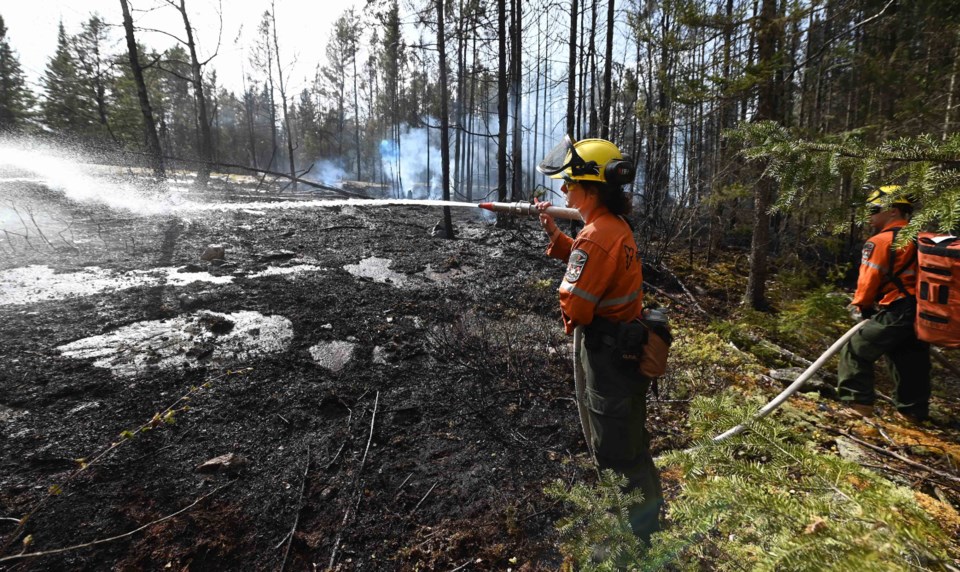SUDBURY — An ongoing health and safety research project aims to better understand the effects of wildland fire smoke and other environmental conditions on firefighters.
The work is being done by the Centre for Research in Occupational Safety and Health (or CROSH) at Laurentian University in Sudbury in collaboration with the Ministry of Natural Resources’ Aviation, Forest Fire and Emergency Services. CROSH director Sandra Dorman said it’s a three-year project, which started in 2024.
“When the contract started, basically, we were doing literature reviews and trying to understand what had other provinces or countries done to address the hazards associated with respiratory and dermal (skin) smoke exposure,” she said.
“Then we tried to contextualize that for Ontario.”
Jurisdictions — both within Canada and abroad — operate differently when it comes to wildland firefighting, Dorman said. For example, she said, firefighters in British Columbia don’t live near the fire lines overnight when they’re deployed, whereas in Ontario they do.
Even differences in the natural landscapes where firefighters are working can cause different exposure risks.
“There's differences in the operational part, but there's also differences in what's burning, right?” she said. “Swampy areas are going to produce different chemical mixes — and coniferous trees, which would be different from the brush in Australia, that kind of thing.”
A presentation slide from CROSH stated hazards on the fire lines can include smoke, exhaust, dirt, ash, soot and gases.
This year, Dorman said, the project is focusing on how to coordinate data collection by having some firefighters wear non-intrusive devices (and ones that can operate for long periods of time in remote locations) to take measurements of the environmental conditions they’re working in. She said it's the first such type of data collection in Ontario.
Broadly speaking, she said, some of the areas they’re looking to measure include those of fine particulate matter — which is found in smoke and can be inhaled deeply into the airways, with some particles being able to cross over into the circulatory system — as well as trying to pinpoint when the riskiest times are for exposure.
“Down the line we want to … talk about how do we help protect them, right?” she said. “If we understand the context in which they're having high risk, then we can ideally teach them that, and then ideally have them make decisions on when they can mitigate that high risk.”
The data collection is also slated to include looking at the effects of firefighters being in the field in the vicinity of the fires for extended periods of time.
“Let's say you had a job that also exposed you to particulate, presumably you might go home after work and then you're alleviated from that particulate and that's kind of an opportunity of recovery for you,” Dorman said. “We don't understand even the recovery that these workers have when they are not technically on the fire line, but are back at the campsite.”
“They might not get a recovery period or it might be a lot less than you might think it is, depending on the particular exposure in that environment.”
Wildland firefighters were recently made eligible for presumptive coverage for certain types of cancers, heart injuries and PTSD as municipal firefighters.
Dorman said they’re also looking at silica exposure for forest firefighters. Silica is a provincially-designated substance under the Occupational Health and Safety Act, with exposure common in industries like mining. However, she said, given that fire crews often do tasks like digging trenches and otherwise busting up the ground, they want to know to what extent they’re coming into contact with it.
They also want to study how, and to what extent, environmental conditions in fire areas affect the skin and, by extension, to what extent chemicals are getting through.
“While you're doing your jobs, you're absolutely getting some of that smoke, and other chemicals in the environment, on your skin,” Dorman said. “Some of those chemicals can directly irritate the skin.”
“The ones we're really worried about though are the chemicals that are able to penetrate through the skin.”
And while dermal exposure is an area of concern, she said there wasn’t the capacity to explicitly research it this year but perhaps next summer.
CROSH’s work also produced an educational component for firefighters aimed at better understanding respiratory and dermal hazards on the fire lines and what they can do to better protect themselves before, during and after deployment, she said.
Dorman said it’s time that fire smoke’s effects are being taken seriously.
“I also think the fire season is getting longer, fires are getting worse, they're bigger, there's more of them, and not just in Canada,” she said.
“Now communities are also being exposed to the same hazards that firefighters have always been exposed to, and they're getting concerned.”
